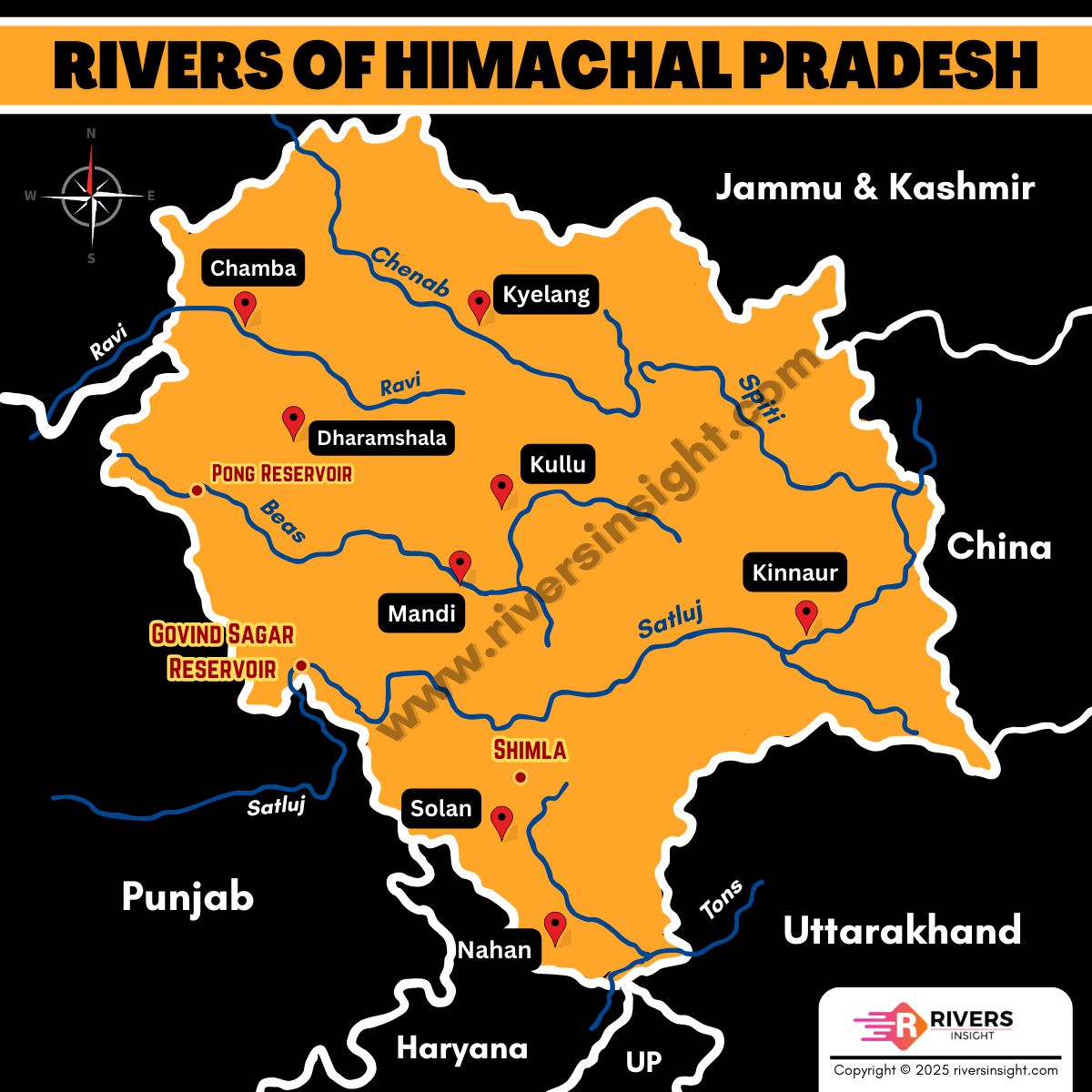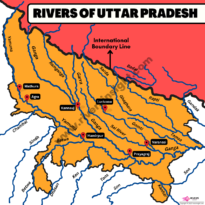Major Rivers of Himachal Pradesh with Map
Himachal Pradesh is a northern Indian state located in the western Himalayas, known for its scenic mountains, deep valleys, and rich river systems. It covers an area of approximately 55,673 square kilometers and shares borders with Jammu and Kashmir and Ladakh to the north, Punjab to the west, Haryana to the southwest, Uttarakhand to the southeast, and the Tibet Autonomous Region of China to the east.
Himachal Pradesh is home to many important rivers that originate from the glaciers of the Himalayas. Most of the rivers in this region are snow-fed and maintain a perennial flow throughout the year. Major rivers such as the Sutlej, Beas, Ravi, Chenab, and Yamuna either originate or flow through the state. The river network in Himachal Pradesh is an essential part of both the Indus and Ganga basins, making the rivers of Himachal Pradesh highly significant for downstream states as well.
Table of Contents
River Basins in Himachal Pradesh
Himachal Pradesh lies within two major river basins:
- The Indus Basin, which covers most of the state and includes rivers like Sutlej, Beas, Ravi, and Chenab
- The Ganga Basin, which covers the southeastern part of the state and includes the Yamuna and its tributaries like the Giri and Pabbar
Major Rivers of Himachal Pradesh
1. Sutlej River
The longest river in Himachal Pradesh. It enters India through Shipki La Pass and flows through districts like Kinnaur, Shimla, and Bilaspur. Major hydropower projects like Bhakra Nangal and Nathpa Jhakri are built on this river.
2. Beas River
Originates from Beas Kund near Rohtang Pass in Kullu district. It flows through Manali, Kullu, Mandi, and Kangra districts before merging with the Sutlej in Punjab. It supports irrigation and tourism in the region.
3. Ravi River
Rises from the Bara Bhangal region of Kangra district. It flows through Chamba and forms part of the Indus River system. Chamera Dam is a significant hydropower project on this river.
4. Chenab River
Formed by the confluence of Chandra and Bhaga rivers at Tandi in Lahaul and Spiti district. It flows northwest into Jammu and Kashmir. The river has potential for major hydropower development.
5. Yamuna River
Though most of the Yamuna flows outside Himachal, it originates from the Yamunotri glacier in Uttarakhand and enters Himachal near Paonta Sahib. Its tributaries Giri and Pabbar flow within the state.
Important Tributaries
Some key tributaries in the state include:
- Parbati, a tributary of the Beas
- Spiti, which joins the Sutlej
- Tirthan, a tributary of the Beas
- Giri and Pabbar, which feed into the Yamuna

Longest River of Himachal
The Sutlej River is the longest river flowing through Himachal Pradesh. It originates in Tibet, near Mount Kailash, and enters India through the Shipki La Pass in the Kinnaur district. The river travels through several districts of Himachal including Kinnaur, Shimla, Kullu, Mandi, Bilaspur, and Una before moving into the plains of Punjab. It supports major hydroelectric projects like Bhakra Nangal Dam and Nathpa Jhakri Hydropower Station, making it a vital river for both the state and the nation.
Important Dams in Himachal Pradesh
Himachal Pradesh, with its abundant river systems and steep terrain, is home to several significant dams that play a vital role in hydroelectric power generation, irrigation, and flood control. Below are some of the most important dams in the state:
- Bhakra Dam: Built on the Sutlej River near the border of Himachal Pradesh and Punjab, it is one of the tallest gravity dams in the world. Though the main structure lies in Punjab, the reservoir—Gobind Sagar—extends deep into Bilaspur district of Himachal Pradesh.
- Pandoh Dam: Constructed on the Beas River in Mandi district, this dam diverts water through tunnels to the Dehar Power House on the Sutlej River, enhancing hydroelectric power generation.
- Nathpa Jhakri Dam: Located in the Kinnaur district on the Sutlej River, it is part of the Nathpa Jhakri Hydroelectric Project, which is one of the largest hydroelectric projects in India with a capacity of 1500 MW.
- Kol Dam: Situated on the Sutlej River in Bilaspur district, Kol Dam is a key project managed by NTPC (National Thermal Power Corporation) and contributes significantly to the power grid of northern India.
- Chamera Dam: Built on the Ravi River near Dalhousie in Chamba district, the Chamera Dam supports the Chamera Hydroelectric Project and is a vital source of renewable energy.




